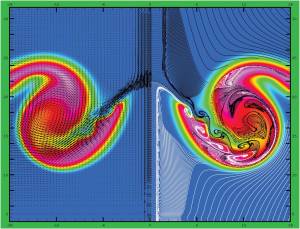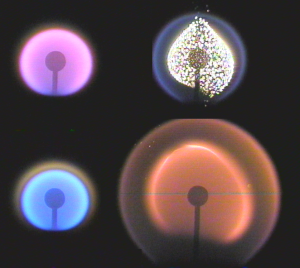
“Low-speed opposing jets of fuel (top) and air (bottom) formed a flat laminar diffusion flame. As the jet velocities are increased a weak turbulent flame is generated. Velocity and particle fields are superimposed on temperature distribution on the left and right halves of the picture, respectively. Particles injected from fuel and air jets are shown with black and white dots, respectively. Jet instabilities generated vortices, which; in turn, enhanced mixing and broadened the reaction zone. The laminar flame at the center is extinguished and the turbulent flame in the wings is stabilized. Turbulent fluctuations are evident in the velocity field and the associated vortical structures are evident in the particle field. Simulations are performed using UNICORN code.”
Viswanath Katta, Terry Mayer, James Gord and William Roquemore (Wright Patterson Air Force Base)

“This is a photo of a full scale flare being tested at sunset at the John Zink R&D Test Center in Tulsa, OK.”
Chuck Baukal (John Zink Company)

“All four flames involve methane/oxygen/nitrogen diffusion flames at 1 bar in the NASA Glenn 2.2 second drop tower. The flame at upper left involves oxygen flowing into 28% (by volume) methane and has unusual pink coloration. The flame at upper right involves methane flowing into 40% oxygen and has large bright soot agglomerates. The flame at lower left involves oxygen flowing into 30% methane and has a bright soot halo outside of the flame sheet. The flame at lower right involves methane flowing into air and has a soot shell well inside of the flame sheet.”
Jason Taylor (National Center for Microgravity Research) and Richard Axelbaum (Washington University)